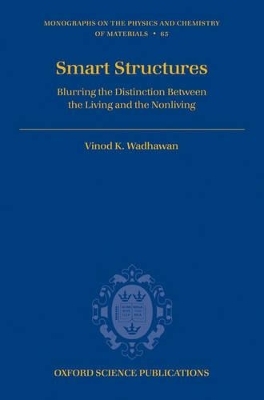
Smart Structures
Oxford University Press (Verlag)
978-0-19-922917-8 (ISBN)
A structure is an assembly that serves an engineering function. A smart structure is one that serves this function smartly, i.e. by responding adaptively in a pre-designed useful and efficient manner to changing environmental conditions. Adaptive behaviour of one or more materials constituting a smart structure requires nonlinear response. This book describes the three main types of nonlinear-response materials: ferroic materials, soft materials, and nanostructured materials. Information processing by biological and artificial smart structures is also discussed. A smart structure typically has sensors, actuators, and a control system. Progress in all these aspects of smart structures has leant heavily on mimicking Nature, and the all-important notion in this context has been that of evolution. Artificial Darwinian and Lamarckian evolution holds the key to the development of truly smart structures. Modestly intelligent robots are already on the horizon. Projections about the low-cost availability of adequate computing power and memory size indicate that the future really belongs to smart structures. This book covers in a compact format the entire gamut of concepts relevant to smart structures. It should be of interest to a wide range of students and professionals in science and engineering.
Dr Vinod Kumar Wadhawan Solid State Physics Division Raja Ramanna Fellow Bhabha Atomic Research Centre Mumbai India M.Sc. (1967) Ph.D. (1976) 1979-80 Nuffield Foundation Travelling Fellow, Clarendon Laboratory, Oxford, U. K. 1985- Regional Editor for Asia, Phase Transitions (Taylor & Francis, U. K.). 1999-2004 Head, Laser Materials Division, Centre for Advanced Technology, Indore. 2000 Recipient of Materials Research Society of India (MRSI) Medal. 2005-2008 Raja Ramanna Fellow, BARC, Mumbai.
1. Introduction and Overview ; 2. Information Processing by Biological and Artificial Smart Structures ; 3. Ferroic Materials ; 4. Soft Matter ; 5. Self-Assembly and Self-Organization of Matter ; 6. Nanostructures ; 7. Human Intelligence ; 8. Smart Sensor Systems ; 9. Sensors and Actuators for Smart Structures ; 10. Machine Intelligence ; 11. The Future of Smart Structures ; Appendices
| Erscheint lt. Verlag | 1.11.2007 |
|---|---|
| Reihe/Serie | Monographs on the Physics and Chemistry of Materials ; 65 |
| Zusatzinfo | 19 black and white line drawings and 1 halftone |
| Verlagsort | Oxford |
| Sprache | englisch |
| Maße | 160 x 240 mm |
| Gewicht | 750 g |
| Themenwelt | Informatik ► Theorie / Studium ► Künstliche Intelligenz / Robotik |
| Naturwissenschaften ► Biologie ► Genetik / Molekularbiologie | |
| Naturwissenschaften ► Physik / Astronomie ► Festkörperphysik | |
| Technik ► Elektrotechnik / Energietechnik | |
| Technik ► Maschinenbau | |
| ISBN-10 | 0-19-922917-1 / 0199229171 |
| ISBN-13 | 978-0-19-922917-8 / 9780199229178 |
| Zustand | Neuware |
| Haben Sie eine Frage zum Produkt? |
aus dem Bereich


